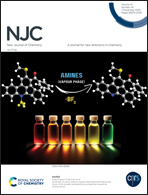Enhancing the electrocatalytic OER activity of Co-MOFs through labile solvents coordination†
Abstract
The coordination environment and networks of metal–organic frameworks (MOFs) play a significant role in their functional properties, especially catalysis. In recent years, the use of MOFs for electrocatalytic water-splitting reactions to produce green hydrogen fuel has gained increasing attention. Herein, we report the preparation of Co-benzene dicarboxylic acid-based MOFs (Co-MOF-1 and Co-MOF-2) with different coordination environments and correlated their structure-controlled electrocatalytic OER activity in an alkaline medium. Both Co-MOF-1 and Co-MOF-2 showed 3D network structures with different coordination environments around the Co metal centre. In Co-MOF-1, the Co metal centre is coordinated with DMF and pyridine along with a benzene dicarboxylic acid (BDC) ligand, whereas the Co metal centre is coordinated only with BDC ligands in Co-MOF-2. The Co metal centres in Co-MOF-1 contain labile solvent coordination but have completely saturated coordination with the BDC ligand alone in Co-MOF-2. Interestingly, Co-MOF-1 showed relatively strong OER activity and required the overpotential (η) of 294 mV to produce 10 mA cm−2 current density. However, Co-MOF-2 required the overpotential of 343 mV to achieve the 10 mA cm−2 current density. Further Co-MOF-1 showed comparatively low Tafel slope and charge transfer resistance and high electrochemical surface area than Co-MOF-2 and supported the enhanced OER activity. XPS analysis of Co-MOF-1 before and after catalysis suggested the conversion of Co-MOF-1 to CoOOH during the electrocatalysis that boosted the OER activity. The presence of a labile coordination site in Co-MOF-1 might have facilitated the interaction of hydroxyl electrolyte with the metal centre and active site generation by forming CoOOH easily which enhanced the OER activity. Co-MOF-1 also showed excellent stability for over 48 h. Hence, the present work provides structural insight for designing new MOFs for electrocatalytic water-splitting reactions.



 Please wait while we load your content...
Please wait while we load your content...